Kentucky has 33 different snake species with 4 being venomous. This states different water sources like rivers, marshes and lakes allow many different water snake species to thrive.
Forest and woodland areas are also prime living spaces for terrestrial snakes. With the destruction and removal of certain habitats some snakes may live close or near humans. Parks, farms, and gardens can house many snake species.
All the venomous snakes in Kentucky are pit vipers. While other snakes may look similar and mimic certain species, they are generally harmless if left alone.
This list will show you all of the snakes found in the state, and facts about each one. While herping and exploring the wilderness it is essential to know what to look out for when encountering a snake species.Hopefully this list of all the snakes in Kentucky will be useful on your next adventure.
Table of Contents
Snakes In Kentucky
1. Copperhead
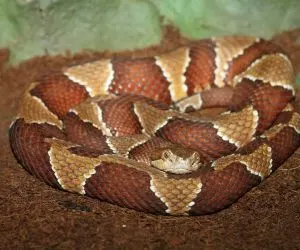
- Experience Level: Intermediate-Advanced
- Family: Viperidae
- Scientific Name: Agkistrodon Contortrix
- Other Names: Eastern Copperhead
- Adult Size: 2-3 Feet Long
- Lifespan: 18-20 years
- Average Price Range: $100 – $300
Copperheads can be found all throughout North America and Kentucky. Forrests, rocky areas, lowland streams and marshes are habitats where these snakes dwell. When the heat of summer comes they are nocturnal, but in spring or fall they are active all day.
Copperheads have thick bodies, and large copper colored heads. Their scales are keeled and can be tan, tannish pink, or brown. Large hourglass blotches run across its back, which are black or dark brown. Sometimes spots occur between the blotches and it’s belly is tan.
Many snakes are thought to be the notorious copperhead, and are thus killed by humans. Their venom is potentially deadly, but a bite will mostly likely just bring pain. A copperhead’s main use for its venom is to neutralize prey like rodents, amphibians, birds, bugs and other small animals it finds.
2. Western Cottonmouth
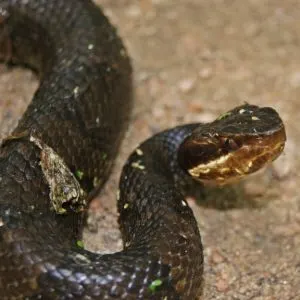
- Experience Level: Advanced
- Family: Viperidae
- Scientific Name: Agkistrodon piscivorus leucostoma
- Other Names: Black Moccasin, Blunt-tail Moccasin, Congo Snake, Cottonmouth, Cotton-mouthed Snake, Gapper, Northern Cottenmouth Moccasin, Stump-tail Water Moccasin, Trap-jaw, Water Moccasin, Western Cottonmouth Moccasin, Viper
- dult Size: 24-48 inches
- Lifespan: 10-20 years
- Average Price Range: N/A
Western Cottonmouths are found in the southeastern United States in swamps, wetlands,rocky areas, lakes and other water habitats. Cottonmouths enjoy swimming in water or basking on land. These snakes are nocturnal, so you will most likely come across it at night. In spring through summer they remain active and mate, but when winter comes they hibernate underground.
A cottonmouth’s body is thick and powerful. Like other venomous snakes they have pits between their catlike eyes. Its body is brown, tan or black. In some snakes they have a band pattern going across their backs. Their stomachs are yellow with brown markings. The main identifying feature of this snake is its big mouth, which is an all white cotton color.
This snake has a diverse diet of sea and land life. Common things it preys upon are mice, birds, fish, lizards, baby alligators, snakes and other small animals. A cottonmouth’s bite can cause extreme damage to someone. When threatened they will flash their mouths open.
3. Timber Rattlesnake
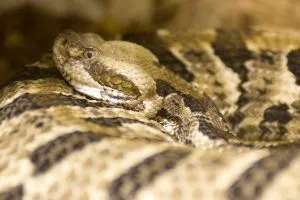
- Experience Level: Advanced
- Family: Viperidae
- Scientific Name: Crotalus horridus
- Other Names: timber rattler
- Adult Size: 30-60 inches
- Lifespan: 10-20 years
- Average Price Range: $300
Timber Rattlesnakes live in heavily forested areas, outcrop ridgelines and rocky locations in Kentucky and the eastern U.S. These snakes are active through spring to fall. In winter they hibernate and take shelter in places like tree stumps and animal burrows.
Timber rattlesnakes are the largest venomous snake found in Kentucky. They have large fangs, which makes their bite one of the deadliest. These snakes are brown, sometimes all black.
They have a dark crossband pattern, with jagged edges. Large triangular heads, and catlike eyes are traits it shares with other venomous snakes. The end of its tail is black with a rattle on it.
Timber rattlesnakes eat mice, squirrels, chipmunks and other rodents. Even though they are venomous many animals like kingsnakes and possums prey upon this snake.
Areas with low human presence deep in the wilderness is where you will most likely come across a Timbers rattlesnake. These snakes are endangered and are in need of conservation in Kentucky.
4. Western Pygmy Rattlesnake
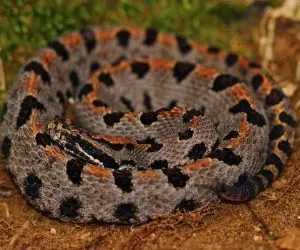
- Experience Level: Intermediate
- Family: Viperidae
- Scientific Name: Sistrurus Miliarius Streckeri
- Other Names: Pygmy rattlesnake, ground rattlers, sand rattlers
- Adult Size: 16-24 inches
- Lifespan: 15-20 years
- Average Price Range: $100
Western Pygmy rattlesnakes live in the southwestern United States and are a rare snake to see in Kentucky. They live in sandhills, forest, flatwoods, by lakes and near water. They are active most in summer at night, and hide under rocks, logs and in animal burrows.
Pygmy rattlesnakes are one of the smallest rattlesnake species. These snakes are gray to tan in color. Black spots cover their back and sides. On some snakes they have a rust colored striped running down their back. Their tail is slender with a small rattle at the end.
These snakes are venomous, but a bite is not deadly. When threatened they shake their tail to create a small buzzing noise. Lizards, small snakes, and mice are the main foods in its diet.
5. Black Rat Snake
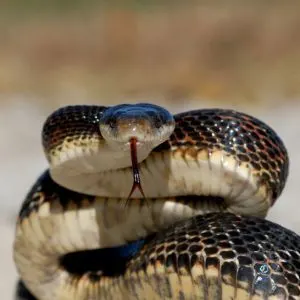
- Experience Level: Intermediate
- Family: Colubridae
- Scientific Name: Pantherophis obsoletus
- Other Names: Pilot black snake, Western rat snake
- Adult Size: 42-84 inches
- Lifespan: 10-15 years
- Average Price Range: $50-$100
Black Rat snakes live in the central and eastern United States. Rocky hillsides, farmlands and forests are some of their preferred habitats.
In Kentucky many people find these snakes hunting for mice in barns and abonded buildings. In forests they explore treetops to look for eggs.
Black rat snakes are usually all black with yellow coloring in between their keeled scales. They have a pale stomach and dark, round eyes. This species is one of the largest snakes in Kentucky and can get up to 6 feet long.
These snakes’ primarily feed on rats and mice. Birds, eggs, lizards and ducks are also common predators. This snake is a constrictor and kills its prey by suffocation. To trick humans and predators, rat snakes may shake their tail to act like a rattlesnake.
6. Black Racer
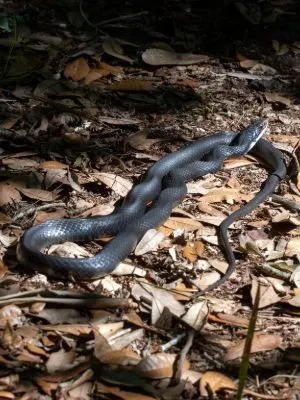
- Experience Level: Advanced
- Family: Colubridae
- Scientific Name: Coluber constrictor priapus
- Other Names: Southern Black racer
- Adult Size: 20-55 inches
- Lifespan: 10 years
- Average Price Range: $25-$40
Black racers inhabit the eastern United states and live all across Kentucky. The various habits this snake lives in includes wetlands, marshes, forests and pastures. This snake enjoys edged habitats and areas near water. It is only active during the day and hides under cover at night.
Black racers are all black with smooth scales and some white coloring under their chin. Their bellies are dark gray or black. It is easy to confuse the black racer with other all black snakes. This snake is the most uniformly black snake and has no patterns or other colors. It is also more slender than other species.
Black racers feed off insects, lizards, birds, other snakes and any small animal it comes across. They use their fast speed to chase or escape other animals. Racers have a healthy population and are a common species to come across.
7. Black Kingsnake
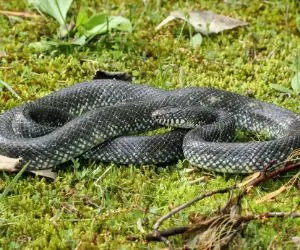
- Experience Level: Beginner -Intermediate
- Family: Colubridae
- Scientific Name: Lampropeltis getula niger
- Other Names: Eastern Kingsnake, Common Kingsnake, Chain Kingsnake
- Adult Size: 4 feet
- Lifespan: 15-25 years
- Average Price Range: $150-$250
Black Kingsnakes are found in most of Kentucky, but not in the north and central areas. They live in forests, swamps, marshes, farmlands and suburban areas. It spends most of its time on land, but will usually be found near a source of water. They have white necks and sometimes a cross pattern.
These snakes are all black with sprinkles of yellow or white spots on their scales. They have white necks and occasional cross bands. This snake’s belly has a white and black checkered pattern and it’s scales are glossy smooth.
Birds, rodents and lizards are eaten by this species. The name “Kingsnake” refers to the fact that this species eats other snakes, including venomous ones.
8. Prairie Kingsnake
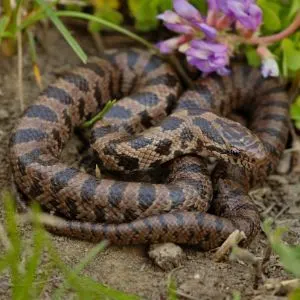
- Experience Level: Beginner-Intermediate
- Family: Colubridae
- Scientific Name: Lampropeltis calligaster
- Other Names: Yellow-bellied Kingsnake
- Adult Size: 30-40 inches
- Lifespan: 15-30 years
- Average Price Range: $100-$200
Prairie kingsnakes live in western Kentucky and can be found across the Midwestern and southeastern United States. Forrests, old fields, prairies, woodlands and pastures are habitats it thrives in. They are very secretive and are often found hiding in abandoned buildings and under objects.
These snakes are brown to gray in color. They have brown to reddish blotches on their backs outlined in black. In some snakes their patterns fade to be a solid brown.
Lizards, frogs and other snakes are what they eat most. When threatened kingsnakes will mimic rattlesnakes or emit a musk from their tail. They are not prone to biting and are generally docile creatures.
9. Milk Snake
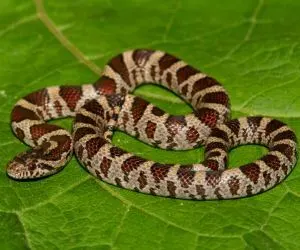
- Experience Level: Beginner
- Family: Colubridae
- Scientific Name: Lampropeltis triangulum
- Other Names: milk snake
- Adult Size: 24-36 inches
- Lifespan: 20 years
- Average Price Range: $100-$300
Milk Snakes are found all across the U.S and Kentucky. They inhabit meadows, forrests, agricultural fields, prairies and edged habitats. Barnes and abandoned buildings are common places to find them due to the high rodent population.
Milk Snakes scales range from gray to brown, with reddish blotches on its back. The blotches are edged in black creep down to the snake’s sides. This species can also be banded with colors of red, tan and black. They have smooth scales and are a smaller species of Kingsnake.
Crickets, slugs, earthworms and other insects are a main part of the Milksnakes diet. They are beloved as pets due to their docile nature and beautiful color.
10. Corn snake
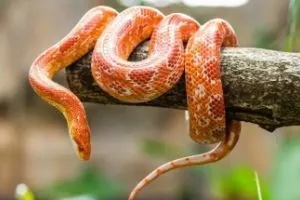
- Experience Level: Beginner
- Family: Colubridae
- Scientific Name: Pantherophis guttatus
- Other Names: Chicken snake
- Adult Size: 4 to 5.5 feet long
- Lifespan: 6 to 8 years
- Average Price Range: $80 to $150
Corn snakes are found in the Mammoth Cave National Park and the Red River Gorge Geologic areas in Kentucky. Forrest, near barns, and agricultural fields are habitats fit for this snake. Corn snakes are a species of rat snake. They spend most of their time on land but are great climbers.
Corn snakes can be orange, red or even grey. They have large blotches that cover their body. The blotches are red or orange and have black edging. Small and slender in size , it has a small head fit with large round eyes.
This snake adapts well to humans and is great at controlling rodent populations. Rodents are a main source of their diet, but birds, eggs and lizards are also consumed by this snake. Corn Snakes are one of the most popular pet species. Beautiful coloring, calm personality and an easy care routine makes them great companions.
11. Scarlet Kingsnake
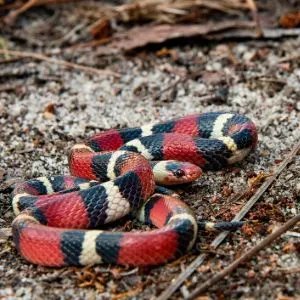
- Experience Level: Beginner
- Family: Colubridae
- Scientific Name: Lampropeltis elapsoides
- Other Names: Scarlet Milksnake
- Adult Size: 14 to 20 inches
- Lifespan: 20 to 30 years
- Average Price Range: $100 to $250
Scarlett Kingsnakes are a species found in southeastern United States and the extreme southwestern areas in Kentucky. They are a rare snake to see in the state, and primarily live in forest areas.
Scarlet Kingsnakes are medium sized with smooth scales. They have vibrant colors of red, black and yellow bands covering their body. Their pattern resembles a coral snake, but the red stripe is never next to the yellow one.
These snakes are nocturnal and spend their time hiding underground or under natural debris. They are predators of lizards, other snakes and small mammals. Kingsnakes are immune to the deadly venom other species produces.
12. Scarlet Snake
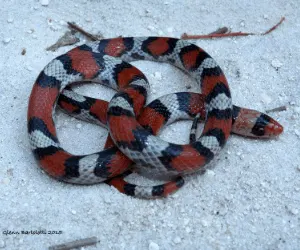
- Experience Level: Advanced
- Family: Colubridae
- Scientific Name: Cemophora coccinea copei
- Other Names: False coral snake, milk snake
- Adult Size: 14-20 inches
- Lifespan: 20-30 years
- Average Price Range: $36-$50
Scarlet Snakes can only be found in the U.S and inhabit parts of western and eastern Kentucky. They spend most of their time hiding under debris and underground. Forests with sandy soil and lots of hiding spots make great habitats for these snakes.
Scarlett snakes are small with pointed heads. They are gray to brown in color, with large red blotches that creep to its side. The blotches are edged in black and do not go to the stomachs. The snake’s belly is a uniform light gray or white color.
Scarlett snakes are active at night and most during summer. Lizards, eggs, rodents, and small lizards are common prey for this snake. Road deaths and destruction of habitat are the main causes for this species decline.
13. Eastern Hognose Snake
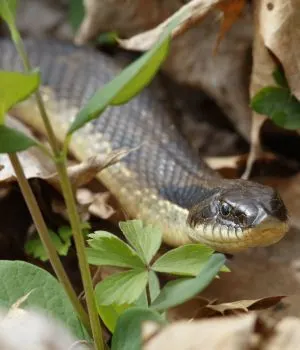
- Experience Level: Advanced
- Family: Colubridae
- Scientific Name: Heterodon platirhinos
- Other Names: Spreading Adder, Deaf Adder
- Adult Size: 28 inches
- Lifespan: 12 years
- Average Price Range: $150-$200
Eastern hognose snakes are found in the eastern half of the U.S and live all throughout Kentucky. Woodlands, wetlands, fields and agricultural areas are habitats fit for this snake. They prefer areas with more sandy soil and are only active in the day.
This snake is easily identified by its upturned nose, which looks similar in appearance to a hog. Black, red, yellow, and dark green are common scale colors. Squared blotches can run down it’s back and their belly is gray to black in color.
Hognose snakes prey on primary amphibians. They are immune to a toad’s venom and have large rear fangs to help consume them. This snake is harmless to humans and can make a great pet. If threatened they may mimic a cobra, hiss, play dead or bite. This species has a healthy population andis commonly seen in the wild.
14. Northern Pine Snake
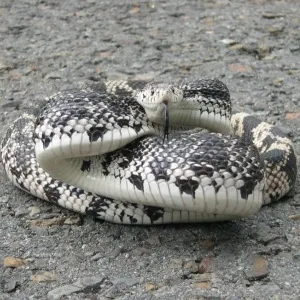
- Experience Level: Intermediate
- Family: Colubridae
- Scientific Name: Pituophis melanoleucus melanoleucus
- Other Names: Pine snake, Bull snake
- Adult Size: 5 to 6 feet
- Lifespan: 20 years
- Average Price Range: $200 to $400
Northern Pine snakes inhabit woodlands, agricultural fields and grasslands in Kentucky. They prefer areas with sandy soil and dry land. These snakes are seen in spring and are underground for most of their life. In spring is when they mate and then they lay eggs in late summer.
These snakes have large bodies with small pointed heads. Pine snakes can be yellow, tan or white with a whitish or yellow stomach. Dark blotches in black or brown cover the snake from head to toe.
Rabbits, squirrels, eggs and other small rodents are eaten by Pinesnakes. Hawks and large rodents prey on this snake. They have a healthy population and are common to find.
15. Eastern Garter Snake
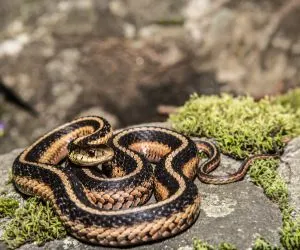
- Experience Level: Beginner
- Family: Colubridae
- Scientific Name: Thamnophis sirtalis sirtalis
- Other Names: dusky garter snake
- Adult Size: 18-26 inches
- Lifespan: 3-10 years
- Average Price Range: $25-$150
Eadstern Garter snakes are one of the most common snakes inhabiting Kentucky and can be found in grassy woodlands, hillsides, forests, wetlands, suburban areas and parks. These snakes love basking in the sun and will flee under a rock if frightened.
Brown, to olive gray in color, these snakes are slender and medium sized. Cream colored stripes run down its back and side.A dark checkered pattern appears on the snake’s back, and its belly is a light cream color.
Eastern Garter snakes are active both day and night. They survive off slugs, earthworms, frogs, salamanders and other small mammals. Their nickname ‘garden snake’ comes from it being seen in many gardens.
16. Eastern Ribbon Snake
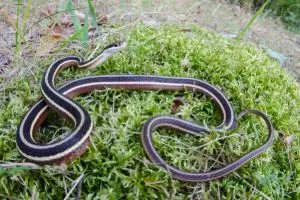
- Experience Level: Beginner
- Family: Colubridae
- Scientific Name: Thamnophis sauritus
- Other Names: Common Ribbon Snake, Blue striped Ribbon Snake
- Adult Size: 18-34 inches
- Lifespan: 12-20 years
- Average Price Range: $25-$50
Eastern Ribbon snakes inhabit highly vegetated areas with water sources like lakes, bogs, marshes and wetlands. They are found in much of the Southeastern United States and in west, and central Kentcuky. These snakes are semi aquatic and are common in the wild.
Eastern ribbon snakes are small and thin. They have dark scales with yellow stripes going down their back. Their belly is pale yellow and around their mouths is white coloring. Their heads are big compared to their body and they have large round eyes.
Fish and amphibians are what this snake eats. They hunt near shallow water and the shoreline. Ribbon snakes are not aggressive and mainly use their camouflage as defense. They can make great pets for beginners.
17. Western Ribbon Snake
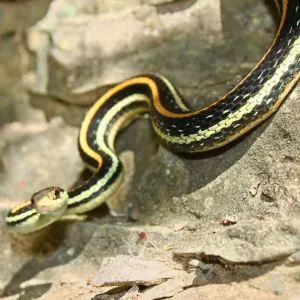
- Experience Level: Beginner
- Family: Colubridae
- Scientific Name: Thamnophis proximus
- Other Names: N/A
- Adult Size: 16-35 inches
- Lifespan: 5-20 years
- Average Price Range: $20-$50
Western Ribbon snakes are found in wetlands, river edges, streams and near riparian zones in the United States and Kentucky. This snake has great movement and can be found in water, on land or in trees.
Western Ribbon snakes are all black with orange stripes running down their back. Yellow or greenish colored stripes run along the sides of its body. Their bellies are light colored and they have large round eyes. Western ribbon snakes have a light spot on their heads, which is absent from the Eastern subspecies.
Fish and amphibians are its main source of food. This species is considered in need of conservation in Kentucky.
18. Rough Green Snake
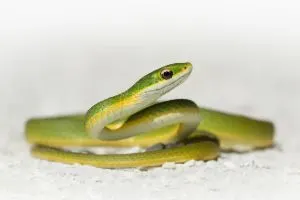
- Experience Level: Intermediate-Advanced
- Family: Colubridae
- Scientific Name: Opheodrys aestivus
- Other Names: Grass snake, Green grass snake
- Adult Size: 22-32 inches
- Lifespan: 8 years
- Average Price Range: $10-$30
Rough Green snakes are found statewide in Kentucky and can live in a variety of habitats. Open forests, edged habitats, bushes, treetops and areas with high vegetation make great homes for this snake. These snakes are active day and night, usually hunting for insects.
Long and slender, their color is bright green. Their belly is a bright yellow and they have rough, keeled scales. Their coloring helps them blend in with grassy habitats, and when they die they turn a sickly blue color.
Small insects and animals are what rough green snakes primarily eat. If not hunting they will usually take shelter under a rock or log. These snakes are shy and prefer to be left alone. They make good pets but can not be handled often.
19. Northern Red-bellied Snake
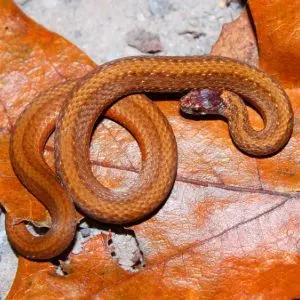
- Experience Level: Beginner
- Family: Colubridae
- Scientific Name: Storeria occipitomaculata occipitomaculata
- Other Names: Fire snake
- Adult Size: 12 inches
- Lifespan: 4 years
- Average Price Range: $50
Northern Redbelly snakes are found all across Kentucky and in forests, woodlands, marshes, bogs and moist habitats. These snakes are secretive and hide underground, logs and other debris. This snake is fossorial and can sometimes be found in gardens.
Gray, tan, yellow or brown are the colors it can be with faint stripes running down its back. Its most prominent trait is its bright red belly, but in some species it can be yellow. Black dots go around its neck, sometimes forming a ring.
Slugs are this snake’s main source of food. Venom helps them paralyze prey, which is delivered by back fangs. This venom is harmless to humans. This snake won’t bite and does a lip curl when threatened.
20. Worm Snake
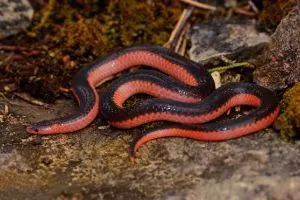
- Experience Level: Beginner
- Family: Colubridae
- Scientific Name: Carphophis
- Other Names: American worm snake
- Adult Size: 13 to 14 inches
- Lifespan: 4 years
- Average Price Range: $20
Worm snakes are found in most of Kentucky but can easily be forgotten about due to their small size. They are common to find under rocks, logs, loose leaf litter and other natural debris. This snake is found in moist and deciduous forests.
Small and thin, it is easy to mistake this snake for an earthworm. They are brown to gray with a yellow belly. Tiny eyes sit upon its small pointed head.
Worm snakes eat earthworms and other soft body insects. Poking with its tail and releasing a smelly musk are defense tactics it uses. Snakes, birds and shrews are some of the larger animals that prey upon this snake.
21. Smooth Earth Snake
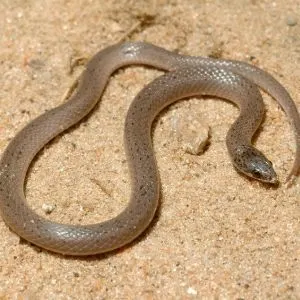
- Experience Level: Beginner
- Family: Colubridae
- Scientific Name: Virginia Valeriae
- Other Names: Western Earth snake
- Adult Size: 7-10 inches
- Lifespan: 7-9 years
- Average Price Range: N/A
Smooth earth snakes live in western and eastern areas of Kentucky. They are fossorial, spending most of their time underground or in loose soil. Forests, wetlands and areas with loose soil are perfect locations for this snake.
Smooth earth snakes are small and never grow larger than 10 inches. They are all brown with smooth scales and occasionally have small black dots. Their stomach is a pale white color and they have tiny heads.
Due to their small size Smooth Earth snakes are generally harmless and if threatened they will just release a foul smelling musk. These snakes are preyed upon by birds, snakes and other mammals. Smooth earth snakes eat earthworms and other soft body insects to survive.
22. Kirtland’s Snake
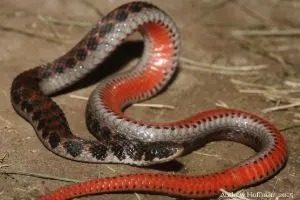
- Experience Level: Advanced
- Family: Colubridae
- Scientific Name: Clonophis kirtlandii
- Other Names: Cora Kennicott’s snake, kirtland water snake
- Adult Size: 14-20 inches
- Lifespan: 1-5 years
- Average Price Range: N/A
Kirtland’s snakes inhabit some areas of northern Kentucky and North America. Forrest, grasslands, wetlands, swamps, wet meadows and damp areas are habitats fit for this species.
These snakes are small and thin. Gray to reddish brown in color, black spots are spread across its back. It’s belly is pink, bordered by white with spots. Their heads are all dark, usually black or greenish in color.
These snakes survive off small insects like slugs. They are preyed upon by Kingsnakes, hawks, bullfrogs and other animals. It is a rare sight to see this species in Kentucky and they are considered “in need of conservation”.
23. Brown Snake
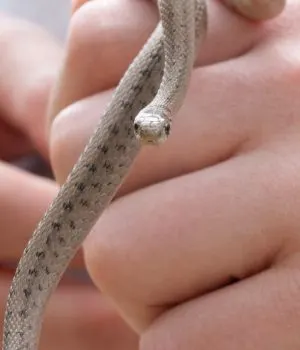
- Experience Level: Beginner
- Family: Colubridae
- Scientific Name: Storeria dekayi
- Other Names: Storeria
- Adult Size: 12 inches
- Lifespan: 7 years old
- Average Price Range: $30
Brown snakes can be found in different habitats across North America and Kentucky. Woodlands, wetlands, agricultural fields, forests and in suburban areas are places they inhabit.
These snakes are usually brown, but can be gray, yellow or light brown. Going down their back is a faint dark stripe and dark spots appear on each side. It’s belly is light brown or white and is covered in tiny spots.
Brown snakes are common and can sometimes be found hiding under rocks, leaves and other natural debris. It is found near residential areas and is known as being a “city snake”. This snake is nocturnal and survives off small insects like worms, snails and slugs.
24. Ringneck Snake
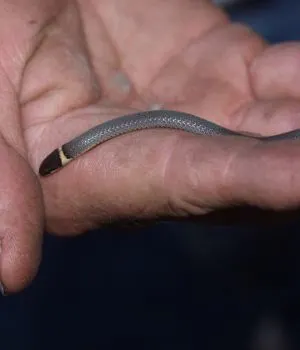
- Experience Level: Beginner
- Family: Colubridae
- Scientific Name: Diadophis punctatus
- Other Names: ring-neck snake
- Adult Size: 10-14 inches
- Lifespan: 6-10 years
- Average Price Range: $40
Ringneck snakes have a large range that stretches over the U.S and most of Kentucky. They live in forested areas hiding under rocks and other natural debris. This snake is very secretive, and hard to study in the wild. It has a healthy population, but is still rare to see due to its nature.
Ringnecks have grey backs and black heads. On their neck sits a bright orange ring, which is where they get their name from. Their stomachs are a bright yellow with black spots spread across its belly.
These snakes are small and rely on a diet of insects. They also enjoy eating small frogs and lizards. Producing a mild venom, they have rear fangs to paralyze tiny prey. When threatened this species will flash its bright belly to confuse predators.
25. Southeastern Crowned Snake
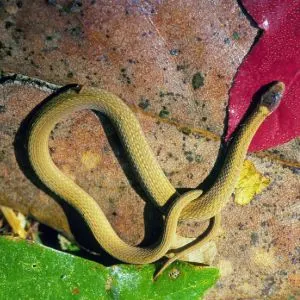
- Experience Level: Beginner
- Family: Colubridae
- Scientific Name: Tantilla coronata
- Other Names: Tantilla snake
- Adult Size: 8 to 10 inches
- Lifespan: N/A
- Average Price Range: $50
The southeastern crowned snake can be found in the southeastern states of the U.S and western Kentucky. Woodlands and areas with lots of leaf litter make a perfect home for this snake. This species is rare to see due to its secretive nature. Under rocks and natural debris is where they hideout.
This snake is small and slender. Tan in color, they have smooth scales. Their head and neck is all black with a tan ring separating the two.
Crowned snakes eat worms, larvae, snails, spiders and other insects they come across. It spends most of its time underground or hiding. This snake produces mild venom which is harmless to humans.
26. Northern Water Snake
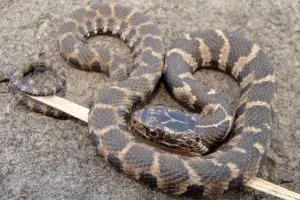
- Experience Level: Intermediate
- Family: Colubridae
- Scientific Name: Nerodia sipedon
- Other Names: Banded water snake
- Adult Size: 48-54 inches
- Lifespan: 9 years
- Average Price Range: $20
Northern water snakes live in water sources all throughout the state of Kentucky. Rivers, marshes, ponds, streams in urban and suburban areas are habitats fit for this species.
Northern water snakes can be brown, gray or black and are covered with blotches. Their markings are red to light brown in color and appear on their sides and back. This species is often confused with cottonmouths. Cottonmouths have a band pattern and a white mouth, which this species lacks.
Fish and amphibians are main components of their diet. These snakes are active in the day and night, spending most of their time hunting. Common to find in the wild, these snakes have a healthy population.
27. Diamond-backed Water Snake
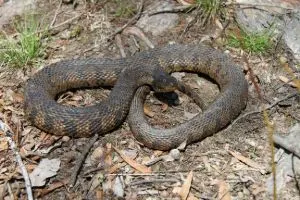
- Experience Level: Advanced
- Family: Colubridae
- Scientific Name: Nerodia rhombifer
- Other Names: Diamondback water snake
- Adult Size: 30-63 inches
- Lifespan: 9 years
- Average Price Range: $50
Diamondback water snakes live in the Central United States near slow moving waters like ponds, streams, rivers and lakes. In Kentucky they inhabit the Jackson purchase and coalfields area.
These snakes are long and heavy bodied. They can be gray, light yellow or tan. Dark brown blotches run across its back and create a chain like pattern. Its belly is yellow with crescent or spot patterns on it. The snake’s scales are rough and keeled and its teeth are sharp.
Diamond backed water snakes eat fish, frogs and other water life.They sometimes hang from trees and try to pick fish from the water. These snakes are not venomous but will bite and spray mus to defend itself.
28. Copperbelly Water Snake
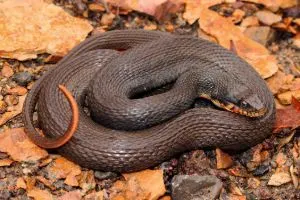
- Experience Level: Advanced
- Family: Colubridae
- Scientific Name: Nerodia erythrogaster neglecta
- Other Names: copperbelly
- Adult Size: 24-48 inches
- Lifespan: 8-10 years
- Average Price Range: $50
Copperbelly water snakes live in wet and warm habitats across North America and western Kentucky. These snakes prefer swampy areas and still water sources. Upland and lowland forests are common habitats. This snake relies on vernal wetlands to survive, since it uses it for reproduction.
This snake’s bright copper stomach is its most defining feature. They are a medium sized snake, with dark brown, blue or black skin.
Copperbelly water snakes spend more time on land than any other water snake in Kentucky. They enjoy climbing trees or relaxing on rocks. Copperbelly snakes feed upon frogs, tadpoles and other amphibians. It often hunts by opening its mouth in running water, and waiting for prey to come along.
This species is protected and it is illegal to hunt or own it in Kentucky. Water birds, other snakes and raccoons and hawks commonly prey upon this snake.
29. Queen Snake
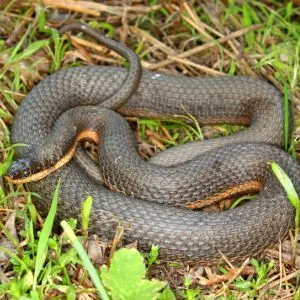
- Experience Level: Intermediate-Advanced
- Family: Colubridae
- Scientific Name: Regina septemvittata
- Other Names: brown queen snake, queen water snake
- Adult Size: 13-36 inches
- Lifespan: 19 years
- Average Price Range: $20-$50
Queen snakes can be found in central Kentucky, and are always around areas with clean moving waters and rocks. They live in ponds, lakes, and rivers with lots of vegetation. They enjoy basking in the sun on bushes or branches, being active during the day.
These water snakes are long and slender, with a small head. They are grayish in color but can be olive green or brown. Stripes run down its sides and on its yellowish belly, which are colored brown, black or yellow.
Queen snakes survive off a diet of mostly crayfish. They prefer them to be freshly molted and search for them by looking under rocks.
Other prey includes frogs, snails, fish, shrimps, and small minnows. These snakes are docile and easily handled, making great pets for beginners.
30. Western Mud Snake
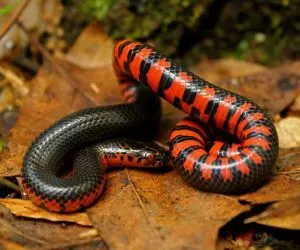
- Experience Level: Advanced
- Family: Colubridae
- Scientific Name: Farancia abacura reinwardtii
- Other Names: Mud snake
- Adult Size: 40-54 inches
- Lifespan: N/A
- Average Price Range: $80-$100
Western Mud Snakes live in rivers, marshes, swamps and other aquatic habitats in North America and western Ketnucky. When hatched in late summer, baby mud snakes spend their first winter on land until they go into the water. These snakes are rarely seen since they spend so much time in water. They do sometimes travel from water and are spotted traveling across the land.
Mud Snakes are large with a thick, round head. They are all black with shiny smooth scales. On their belly sits a checkered pattern that ranges in color pink to red. It has big wide eyes and a large mouth.
Mud Snakes survive mostly off of salamanders, but will eat other amphibians. This snake is not venomous and will not bite. When threatened it will poke you with the end of its tail, which makes this snake generally harmless.
31. Mississippi Green Water Snake
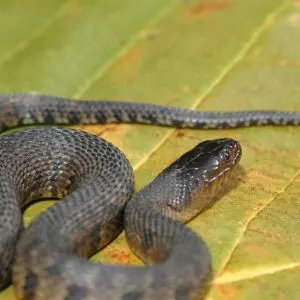
- Experience Level: Advanced
- Family: Colubridae
- Scientific Name: Nerodia cyclopion
- Other Names: Green water snake
- Adult Size: 30-45 inches
- Lifespan: 8-15 years
- Average Price Range: $20-$50
Mississippi Green Water snakes are found only in the United States and along the Mississippi River. In Kentucky they can be found in the most western water ways. This snake can be found often in freshwater lakes, marshes, rivers and sloughs.
These snakes are brown, tan or greenish, with smooth glossy scales. Their bellies are dark with yellow spots. Two or three scales surround the eyes and form a ring looking shape, which helps differentiate it from other water snakes.
This snake will normally flee if approached, but if aggravated they do not hesitate to strike. Their big jaws and fast swimming help hunt down prey. Mississippi green water snakes eat mostly fish and amphibians they find while swimming.
32. Broad-Banded Water Snake
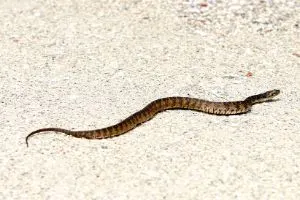
- Experience Level: Beginner
- Family: Colubridae
- Scientific Name: Nerodia Fasciata Confluens
- Other Names: Southern Water Snake
- Adult Size: 22-42 inches
- Lifespan: 8-10 years
- Average Price Range: $20-$50
Broad-Banded water snakes live in North America and the extreme western areas of Kentucky. They live in aquatic habitats like swamps, oxbow lakes and river sloughs. These snakes are active mostly at night and can be seen basking in the sun, near vegetation or hanging on branches.
Broad Banded Water Snakes have large dark bands that cover its body with orange, yellow or tan coloring in between. They have yellow bellies with dark square spots.
Fast swimming helps the snake catch prey like fish, frogs and other small animals. It is not venomous and if threatened it will flatten out its body to seem larger. This snake is not endangered and can and can make good beginner pets.
33. Plain-bellied Water Snake
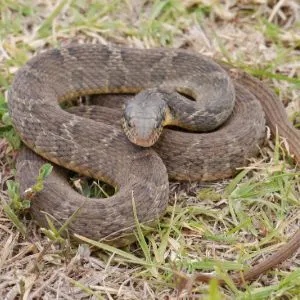
- Experience Level: Advanced
- Family: Colubridae
- Scientific Name: Nerodia erythrogaster flavigaster
- Other Names:
- Adult Size: 30-48 inches
- Lifespan: 8-10 years
- Average Price Range: $50
Plain-bellied water snakes live in western Kentucky and are spread across the Southeastern United States. They are always found near a source of water, and prefer habitats like marshes, swamps, wetlands, ponds, lakes and bottomland hardwood forests. Hibernating during winter, it is only in the warm and hotter months they become active all day. It is common to find them basking on logs or swimming in water.
Plain Bellied water snakes are big with brown, gray, olive green, and black scales. It has no patterns on its body. It’s belly can be red to tan in color, and helps identify it from other water snakes since it has no markings.
In water or near water is where this snake gets most of its food. Frogs, fish, crayfish and salamanders are a main part of their diet. It swallows its prey whole and sometimes sits in the water waiting for something to come along.
Wrapping up
Kentucky’s 33 different species of snakes are all unique. Pattern, behavior, location and size are some things to look out for when trying to identify a species. While many people don’t like snakes, they are very beneficial in keeping a balanced ecosystem.
Some of the snakes on this list can make great pets. Species with docile tempers and simple lifestyles make the best pets. It is always best to research a species before deciding to get one. Some snakes should not be brought from the wild, since they may be endangered and are a valuable part of the ecosystem.
Kentucky is great for reptile and snake lovers. The various habitats and wildlife create an ever exciting environment. If out in the wild or herping locally, hopefully this list will be helpful on your next adventure.
Snakes in other states
- Snakes in Illinois
- Snakes in Ohio
- Snakes in Missouri
- Snakes in Tennessee
- Water Snakes in Virginia
- Snakes in West Virginia
